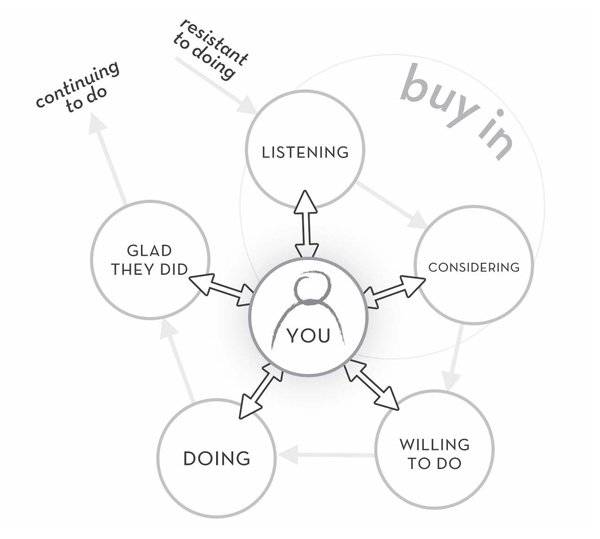1
Who’s Holding You Hostage?
Good management is the art of making problems so interesting and their solutions so constructive that everyone wants to get to work and deal with them.
—PAUL HAWKEN, AUTHOR, NATURAL CAPITALISM
Right now, there’s someone in your life you need to reach. But you can’t, and it’s driving you crazy. Maybe it’s somebody at work: a subordinate, a team member, a client, your boss. Or maybe it’s somebody at home: a partner, a parent, a defiant teen, an angry “ex.”
You’ve tried everything—logic, persuasion, forcefulness, pleading, anger—but you’ve hit a wall every time. You’re mad, scared, or frustrated. And you’re thinking, “What now?”
Here’s what I want you to do: Think of this as a hostage situation. Why? Because you can’t get free. You’re trapped by another person’s resistance, fear, hostility, apathy, stubbornness, self-centeredness, or neediness—and by your own inability to take effective action.
And that’s where I come in.
I’m just an average guy—husband, father, doctor—but a long time ago, I discovered that I had a special talent. You could drop me into just about any situation, and I could reach people. I could persuade defiant executives, angry employees, or self-destructing management teams to work cooperatively toward solutions. I could get through to families in turmoil and to married couples who hated each other’s guts. I could even change the minds of hostage takers and desperate people contemplating suicide.
I wasn’t sure what I was doing differently from everybody else, but I could tell it worked. I knew I wasn’t smarter than everybody else, and I knew my success wasn’t just luck because what I did worked consistently, and it worked with all kinds of people in every type of situation. But why did it work?
In analyzing my methods, I found the answer. It turned out I’d happened on a simple, quick set of techniques—some I’d discovered on my own, and others I’d learned from mentors and colleagues—that create traction. That is, they pull people toward me, even if those people are trying to pull away.
To understand this, picture yourself driving up a steep hill. Your tires slip and slide and can’t grab hold. But downshift, and you get control. It’s like pulling the road to meet you.
Most people upshift when they want to get through to other people. They persuade. They encourage. They argue. They push. And in the process, they create resistance. When you use the techniques I offer, you’ll do exactly the opposite—you’ll listen, ask, mirror, and reflect back to people what you’ve heard. When you do, they will feel seen, understood, and felt—and that unexpected downshift will draw them to you.
The powerful techniques you’ll learn in this book can move people rapidly and easily, often within minutes, from “no” to “yes.” I employ them every day to fix broken families and help warring couples fall in love again. I use them to save companies on the brink of meltdown, get feuding managers to work together effectively, and empower salespeople to make “impossible” sales. And I use them to help FBI agents and hostage negotiators succeed in the toughest situations possible, when life and death are on the line.
In fact, as you’ll find out, you have a lot in common with hostage negotiators when it comes to reaching the people who don’t want to listen to you. That’s why this book starts with Frank’s story.
The Persuasion Cycle
You probably don’t find yourself in the types of situations that hostage negotiators handle. But on any given day, who are you trying to persuade to do something?
The answer is: nearly everybody you meet. Almost all communication is an effort to get through to people and cause them to do something different than they were doing before. Maybe you’re trying to sell them something. Maybe you’re trying to talk sense into them. Or maybe you need to impress them that you’re the right person for a job, a promotion, or a relationship.
But here’s the challenge: People have their own needs, desires, and agendas. They have secrets they’re hiding from you. And they’re stressed, busy, and often feeling like they’re in over their heads. To cope with their stress and insecurity, they throw up mental barricades that make it difficult to reach them even if they share your goals, and nearly impossible if they’re hostile.
Approach these people armed solely with reason and facts, or resort to arguing or encouraging or pleading, and you’ll expect to get through—but often you won’t. Instead, you’ll get smacked down, and you’ll never have a clue why. (How often have you walked away from a sales pitch, an office meeting, or an argument with your partner or child, shaking your head and saying, “What the heck just happened?”)
The good news is that you can get through, simply by changing your approach. The techniques I describe in this book work for hostage negotiators in the most desperate situations, and they’re equally potent if you’re trying to reach a boss, a coworker, a client, a lover, or even an angry teenager. They’re easy, they’re fast, and you can hit the ground running with them.
These techniques are powerful because they address the core of successful communication: what I call the “Persuasion Cycle” (see Figure 1-1). In developing the Persuasion Cycle, I was inspired by the ground-breaking work and ideas of James Prochaska and Carlo DiClemente in their Transtheoretical Model of Change and by William R. Miller and Stephen Rollnick in their creation of Motivational Interviewing.
All persuasion moves through the steps of this cycle. To take people from the beginning to the end of the Persuasion Cycle, you need to speak with them in a manner that moves them:
■ From resisting to listening
■ From listening to considering
■ From considering to willing to do
■ From willing to do to doing
■ From doing to glad they did and continuing to do
The focus, central tenet, and promise of this book, “the secret of getting through to absolutely anyone,” is that you get through to people by having them “buy in.” “Buy-in” occurs when people move from “resisting” to “listening” to “considering” what you’re saying.
Ironically, the key to gaining “buy-in” and then moving people through the rest of the cycle is not what you tell them, but what you get them to tell you—and what happens in their minds in the process
In the following chapters, I’ll lay out nine basic rules and twelve quick techniques you can use to move people through different points on the Persuasion Cycle. Master these rules and techniques, and you can put them to work wherever you go in your career or personal life. They’re the same concepts I teach FBI agents and hostage negotiators for building empathy, de-escalating conflict, and gaining buy-in to a desired solution—and when you know them, you won’t need to be held hostage by another person’s anger, fear, lack of interest, or hidden agenda. That’s because you’ll have the tools you need to turn the situation to your advantage.
As you read this book, you’ll find multiple options for handling any situation. That’s because while we’re all similar in many ways, we each have our own way of doing things. The rules I outline in Section II are universal, but feel free to hand-pick the techniques in Sections III and IV that suit your personality and your life.
The Secret: Getting Through Is Simple
There’s nothing magic about the approaches you’ll learn in these pages. In fact, one secret you’ll discover is that reaching people is easier than it looks. To illustrate that point, I’ll share the story of David, a CEO who used my techniques to turn his career around—and to save his family at the same time.
What’s the moral of this story? That the right words have tremendous power to heal. In David’s case, a few hundred words saved his job, his company, and his relationship with his son.
But there’s a second lesson here. Look at the two stories in this chapter, and you’ll see that Detective Kramer and David used some of the same approaches to achieve very different goals. Detective Kramer kept a troubled man from killing himself, while David kept his company from firing him and mended the fractures in his family. The power of these techniques, and the others you’ll learn, lies in the fact that they apply to nearly any person and any situation.
Why does a single set of communication tools have such universal power? Because while our lives and our problems are very different, our brains work in similar ways. In the next chapter, we’ll take a very quick look at why our minds “buy in” or “buy out”— and why reaching an unreachable person depends on talking to the brain.

